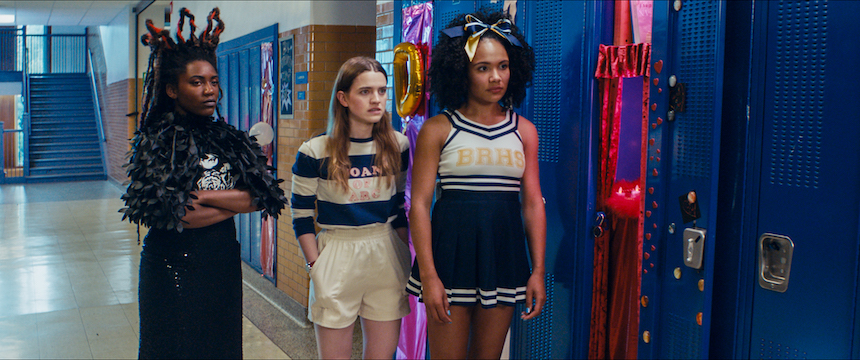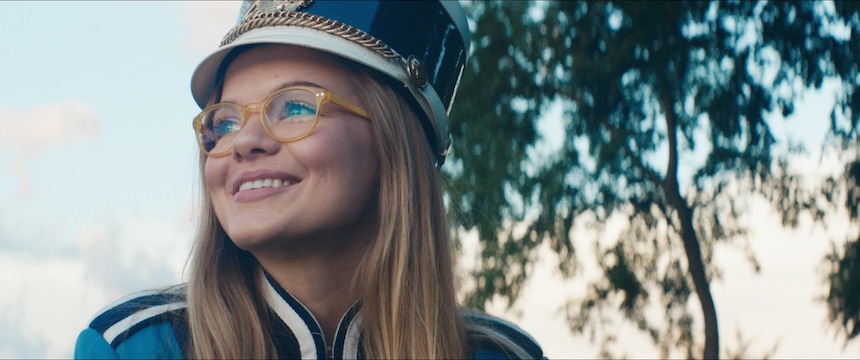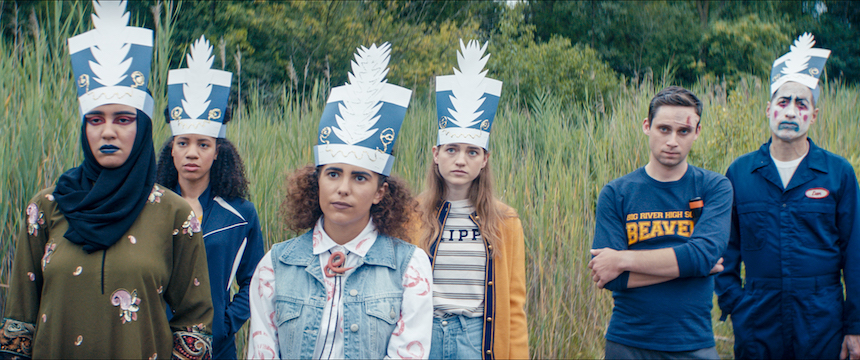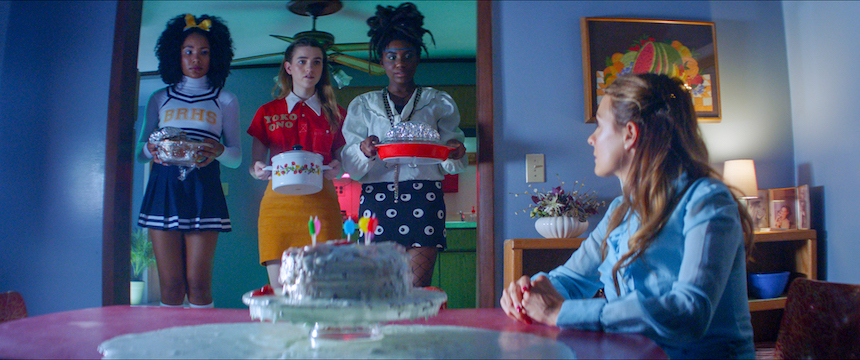Interview: Director Jennifer Reeder On The Sadness And Hopefulness Of KNIVES AND SKIN

In Knives and Skin, a date between two high school students, Carolyn Harper (Raven Whitley) and Andy Kitzmiller (Ty Olwin), goes terribly wrong, leading to misogynistic attitudes and the disappearance of the young girl.
While writer/director Jennifer Reeder uses the setting of a film noir, with some Twin Peaks vibe to it, Knives and Skin is really more like a weird collage of small-town characters that are related somehow to the missing Carolyn Harper and that are dealing with their very own conflicts. By following other teenagers (actresses Grace Smith and Kayla Carter are part of the young cast) and the (equally troubled) adults in their lives (including Carolyn’s mother Lisa, played by Marika Engelhardt), Knives and Skin touches many dark themes (from grief to mental illness) but it also shows the importance of love and coming together in turbulent times.
After playing at such film festivals as the Berlinale and Fantastic Fest, Knives and Skin is now in select theaters and available on VOD and Digital; therefore here’s the full conversation I had with Reeder.
ScreenAnarchy: KNIVES AND SKIN has many themes but how did it all start?
Jennifer Reeder: Knives and Skin is based on scenes that I worked out in a bunch of short films that I made over the past five or six years, which are actually available to the public in free on my Vimeo page, if anyone is curious about what I’ve been up to before Knives and Skin. Those films have dealt with, like I said, similar themes: the idea of coming-of-age, characters coping with trauma, often times people sing, objects float and glow. Many of the elements of Knives and Skin, that perhaps are sort of unexpected, I worked out in short films.
But the actual core of Knives and Skin came from a drive I was taking through Ohio, I was driving along a rural, two-lane road. And I had this idea about three kind of goth punk teenage girls walking along that road, maybe on their way to school, perhaps on their way to band practice, perhaps just passing the time. I thought that that was a really interesting visual analogy for a person who’s at a crossroads in their lives, someone who just seems to be at odds in their environment. Then I go and started thinking, OK, who are these girls and what is about to happen to them that will change their lives forever? Knives and Skin was born from there.

With the disappearance of the protagonist, it begins as a film noir, with a mystery in a small-town that recalls something like TWIN PEAKS. How was your approach to the genre?
I think of Knives and Skin as being kind of genre adjacent, in the sense that it uses elements from horror or thriller, noir, the teen film and even the musical, to enter a different kind of story.
I very much know that I put a lot into this film, a lot to keep track of, there’s a lot of people to keep track of, a lot of storylines to keep track of, and a lot of different genres to keep track of. I did it all very purposely and intentionally, but I wanted to use specifically the horror or thriller genre to talk about everyday scariness, like being a girl and trying to navigate around the adults in your life who are constantly trying to disrupt your human evolution; or the horror of not knowing where your loved one is, for instance.
It’s ultimately a story about human connections, about love and about loss, about female entitlement, for instance. But it starts off behind a curtain of genre, I mean I love genre films quite a bit and I think that the best genre films ever made, from the beginning to contemporary, are ones where elements of the main story are really more broad than just a murder mystery, for instance.
We, as the audience, maybe expect that it will be all about the mystery but then you take time to explore every character and their conflicts. How difficult was to do a film like this one with many storylines?
That was the hard part, honestly, when I was writing the script, just to keep on track with everybody. A very early draft of the script actually included many more people, as you can imagine.
I wanted to make sure that each character had a distinctive arc and that all of the arcs were dealt with consistently and throughly. And I wanted to make a film that was not lost in that ensamble, it really felt important that everybody’s arc actually sort of leads back to Carolyn Harper. It really is in a way her story, and that she, Carolyn Harper, the missing girl, is the catalyst for all of the change that happens with everybody. And once I realized that she was the anchor then it actually, in the writing process, became much easier to keep track of everybody in their arc because it all had to lead back to Carolyn Harper.

You are exploring teenagers’ conflicts but also pretty much every adult in the film is troubled as well. How was the process to write different types of characters?
In a way that was the fun part. I actually really love writing difficult characters or characters facing a difficulty and coping in an unexpected way. I think that’s perhaps one of the parts of the film that people find the most surprising, is that most of the characters’ coping mechanisms are perhaps unexpected or surprising or not common necessarily, and even leaning into the absurd for instance, which I did very purposely.
But that was actually really fun, it was great to have so many different people kind of breaking down all at the same time. I really love films with ensamble casts, and as much as it was hard to keep track of everyone in this film, I don’t regret that it was an ensamble cast.
I actually live in Mexico so the subject of violence against women and the disappearance of women is very relevant today. At the core of KNIVES AND SKIN we see a mother suffering for her missing daughter, so what can you comment on these situations that unfortunately we see everyday?
I understand that it’s a crisis in Mexico. And it’s a crisis in the U.S., more specifically among young women of color. So I didn’t want to make a film that put on this kind of violence against women without saying “this is a film about violence against women”, you know? Because it is a reality, an extremely tragic, totally unspeakable reality, it’s hard to take on a subject matter that can for so many be so close to home. But I also don’t think that we talk about it enough and I think that in the U.S., for instance, we are a culture that is obsessed with youth and beauty, especially among young women, and yet young women are the ones who suffer from so much violence. I think that could be especially true in Mexico as well.
Until we, as a culture, think about a philosophy that simply is about commitment to human equality, then the reality of violence against women will prevail. I’m a mother and I can’t even imagine the horror of not knowing where my child is. I know so well that there are so many parents and brothers and sisters and friends who have missing people in their lives, specifically missing women. I don’t mean to make a fictional story that makes light of it by any means, you know?
At the end we see Carolyn Harper’s mother just shredded with grief, that’s really quite real. There’s a heaviness in this film that it ties to exactly what you say: real events. Fiction, whether is a film or a novel, is a way for people to start very hard conversations, in this case the hard conversation is around violence against women.

For all the dark themes in the film, there’s some light at its ending, because many of the characters come together. What can you comment on this decision?
Absolutely! I wanted to make a film that was hopeful. I don’t presume that the ending is happy necessarily but it’s a hopeful ending. I’m not a hard-hearted person, I love human creatures, for all of our faults.
I wanted to make a film that, as you say, has a lot of sadness but that at the end it provides hope so that we can learn from our mistakes, it says that we can grow from trauma, it says that we are the sum of the things that we’ve done in the past and that tomorrow is a new day. Ultimately, it also suggests that we are better together and that relationships matter, relationships among couples, among siblings, among parents and children, among friends, relationships are what really get us through ultimately and we should value and cherish the human connections that we make.
Nowadays we are used to movies that tell you everything but this one remains mysterious. Why did you decide to take this direction?
The whole film has a very specific visual language and as a filmmaker but also as a film consumer, I watch a lot of films and I love films that allow me to use my own imagination and do a little bit of work to figure out what’s going on in the story. And I love films that utilize production design and really take into consideration the set decoration, the wardrobe and the color palette.
I didn’t go to film school, I went to art school and so my films, not just Knives and Skin but the shorts that I’ve done prior to Knives and Skin also have a very specific visual style. Even as a film consumer, I’m very much drawn to films that take into consideration production design as part of the narrative content.







